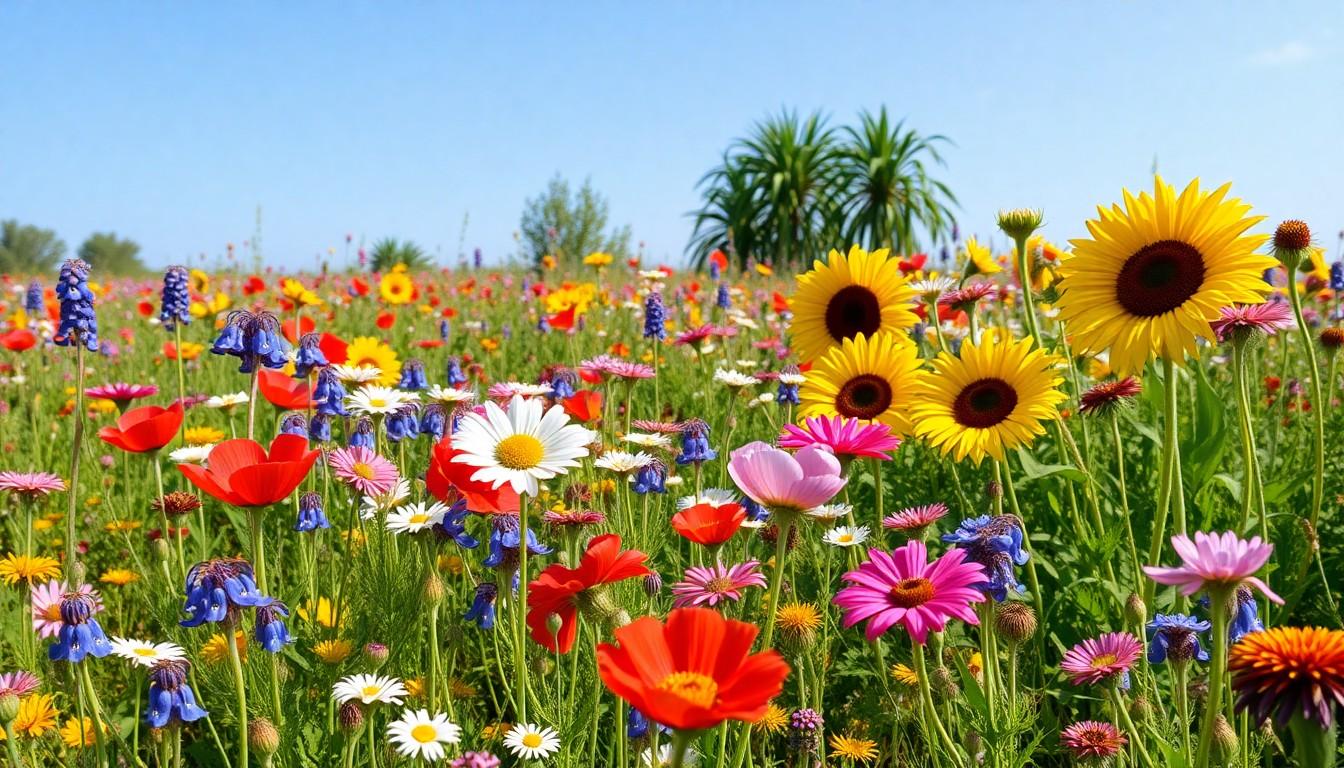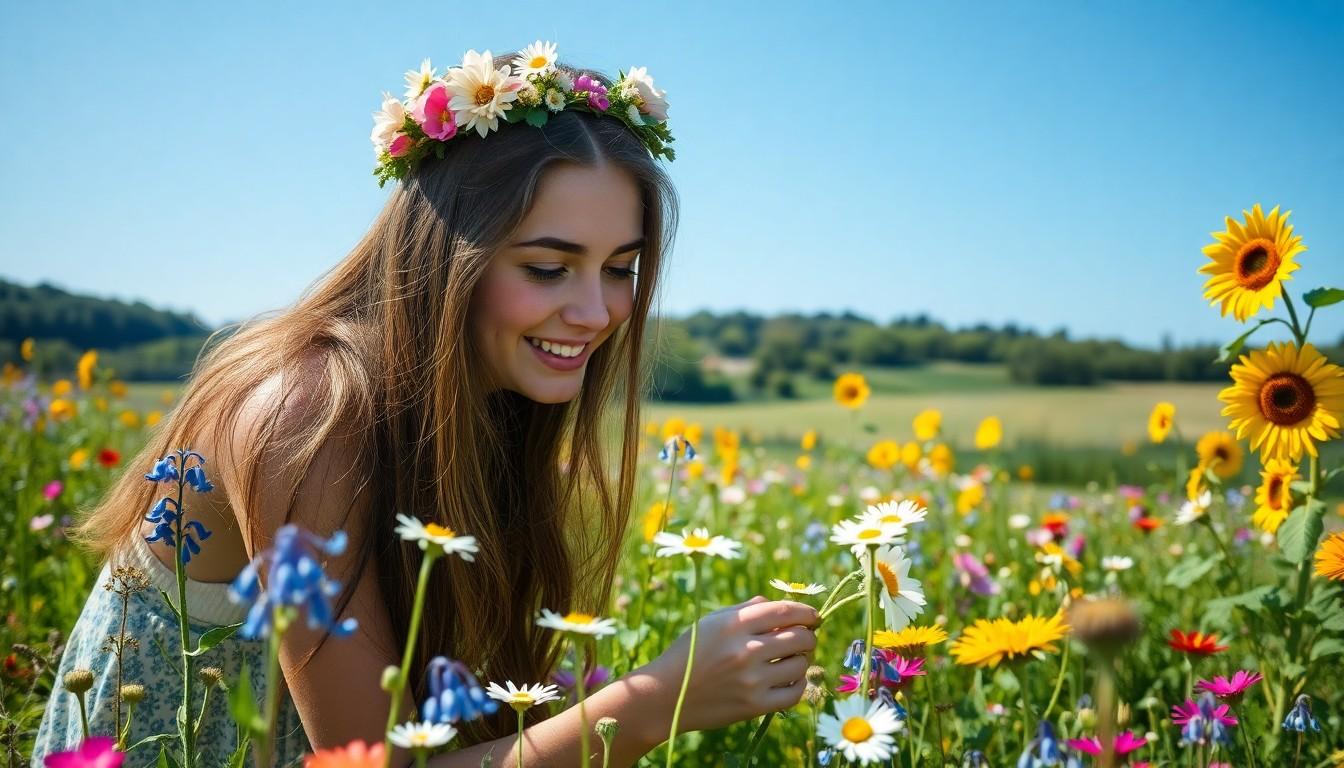Field flowers are nature’s confetti, bursting with color and charm wherever they bloom. They transform ordinary landscapes into vibrant tapestries, inviting everyone to stop and smell the roses—or at least the daisies. From the delicate bluebells to the cheerful sunflowers, these floral wonders not only brighten up the scenery but also play a crucial role in the ecosystem.
Overview of Field Flowers
Field flowers represent a diverse range of species thriving in natural habitats across various regions. Bluebells, daisies, and sunflowers contribute vibrant colors that transform meadows into picturesque landscapes. These blooms provide critical support to local wildlife, offering food sources for insects, birds, and small mammals.
Ecological roles of field flowers extend beyond aesthetics. Pollination occurs when bees, butterflies, and other insects visit these flowers, facilitating the reproductive cycles of many plants. Some field flowers, like clover and dandelions, act as early spring food sources for pollinators emerging from winter dormancy.
Field flowers host unique adaptations. For instance, some species exhibit traits that allow them to survive in poor soil or harsh weather conditions. These resilient plants often flourish in disturbed areas, demonstrating their ability to colonize new environments effectively. A diverse assortment of field flowers can stabilize soil and prevent erosion, enhancing ecological health.
Cultural significance of field flowers varies widely. They fill bouquets for celebrations and convey emotions through floral symbolism. Certain flowers, such as poppies and cornflowers, are intertwined with historical meanings, often commemorating events and lives lost.
Human interaction with field flowers encourages conservation efforts. Awareness initiatives promote the importance of preserving native species and habitats. Many gardening enthusiasts choose to plant native field flowers to support local ecosystems, enhancing biodiversity.
Field flowers exemplify nature’s beauty and ecological importance, captivating observers while playing vital roles in their environments. Individuals can appreciate and protect these incredible floral displays in their local settings.
Types of Field Flowers

Field flowers vary widely, showcasing a rich diversity across different ecosystems. They can typically be categorized into wildflowers and cultivated varieties.
Wildflowers
Wildflowers thrive in natural settings without direct human intervention. Examples include bluebells, daisies, and poppies, each displaying unique adaptations to survive in their habitats. These flowers support local wildlife by providing critical resources such as nectar and pollen. They also aid in pollination, ensuring healthy ecosystems. Many wildflowers bloom seasonally, contributing vibrant colors and attracting pollinators like bees and butterflies. Their resilience against harsh weather conditions highlights their ecological significance.
Cultivated Varieties
Cultivated varieties of field flowers are intentionally grown for aesthetic or agricultural purposes. Popular examples include sunflowers, zinnias, and cosmos. Gardeners often select specific traits, such as color and size, to enhance garden designs. These flowers not only beautify landscapes but also encourage biodiversity by attracting beneficial insects. Cultivated field flowers can help restore native flora and support local wildlife. Through careful management, these varieties contribute positively to their surrounding environments and promote conservation efforts.
Ecological Importance of Field Flowers
Field flowers play a crucial role in maintaining ecosystem balance. These plants host a variety of species, supporting biodiversity across various habitats.
Biodiversity Support
Field flowers enhance biodiversity by providing necessary habitats and resources. Diverse flora supports diverse fauna, creating a balanced ecosystem. Species such as daisies, bluebells, and poppies attract different insects, birds, and small mammals. Each species contributes to ecological interactions essential for the health of local environments. The presence of wildflowers allows native plant species to thrive, preserving local genetic diversity. Field flowers also help bolster food webs, forming an integral part of the local ecosystem while promoting resilience against environmental changes.
Pollinator Attraction
Field flowers serve as vital resources for pollinators. Many bees, butterflies, and other insects rely on these flowers for nectar and pollen. Nectar-rich blooms attract both native bees and migratory species, enhancing ecosystems. Flowers like sunflowers and zinnias offer abundant food sources, thereby encouraging healthy pollinator populations. Active pollinators contribute to the reproduction of flowering plants, creating agricultural benefits. Attracting pollinators sustains not only field flowers but also adjacent crops and wild plants, underscoring their vital ecological role.
Cultivation and Care for Field Flowers
Cultivating field flowers requires attention to soil quality and environmental conditions. Both factors significantly influence growth and blooming.
Soil Preparation
Soil preparation focuses on creating a nutrient-rich foundation. Start by testing soil pH, aiming for a range between 6.0 and 7.5. Amending soil with organic matter, such as compost or aged manure, boosts nutrients. Ensure good drainage by aerating compacted soils, as this promotes root development. Prioritize removing weeds and debris, which can compete with seedlings for essential resources. Incorporate these practices for effective soil health and optimal growth.
Ideal Growing Conditions
Field flowers thrive in specific environments. Most varieties prefer full sun, requiring at least six hours of direct sunlight daily. Adequate moisture is equally important, though many species tolerate drought conditions once established. Maintain soil moisture with regular watering, especially in dry spells. Establishing a diverse planting layout enhances pollinator attraction. Consider the regional climate when selecting species, as this ensures suitable growth conditions while promoting local biodiversity. By meeting these conditions, field flowers flourish and contribute to ecosystem health.
Field Flowers in Culture and Art
Field flowers hold significant cultural value across various societies, symbolizing love, hope, and beauty. Many cultures incorporate flowers like daisies and poppies into literature and art, reflecting themes of nature and life cycles. Floral motifs appear in paintings, textiles, and crafts, showcasing their aesthetic appeal and deeper meanings.
Artists often draw inspiration from wildflowers, using them to evoke emotion and capture fleeting moments in nature. Vincent van Gogh’s sunflower series exemplifies this, expressing vibrancy and warmth through the vivid representation of field flowers. Similarly, Monet’s Impressionist works highlight the ephemeral beauty of wildflowers in their natural habitats, emphasizing their role within living landscapes.
Field flowers also feature prominently in traditional celebrations. Many festivals celebrate the arrival of spring with flower festivals, where fields of blossoms become the backdrop for cultural events. In several regions, people create floral wreaths and garlands using local wildflowers for ceremonies, signifying fertility and renewal.
Historical uses of field flowers further illustrate their cultural significance. Medicinal properties of plants like chamomile and yarrow have been recognized in folk medicine. Additionally, these flowers serve as symbols or tokens in literature, often representing innocence and purity.
Various art movements have recognized field flowers’ importance, infusing them into artistic narratives. The Romantic era frequently depicted wildflowers to express the connection between humanity and nature. Contemporary artists continue this tradition, exploring themes of conservation, identity, and the human experience, often using field flowers as powerful symbols.
By integrating field flowers into artistic expressions and cultural practices, societies celebrate their beauty while fostering appreciation for nature’s delicate ecosystems.
Conclusion
Field flowers are more than just beautiful additions to the landscape; they embody the intricate connections within ecosystems. Their vibrant colors and diverse species not only enhance visual appeal but also play essential roles in supporting wildlife and promoting biodiversity. As society becomes increasingly aware of the importance of conservation, the appreciation for these natural wonders grows.
Cultivating field flowers fosters a deeper connection to nature while contributing to environmental health. Whether in gardens or wild settings, their presence serves as a reminder of nature’s resilience and beauty. Embracing field flowers in both personal and communal spaces can lead to a richer appreciation of the ecosystems they support and the cultural narratives they inspire.
